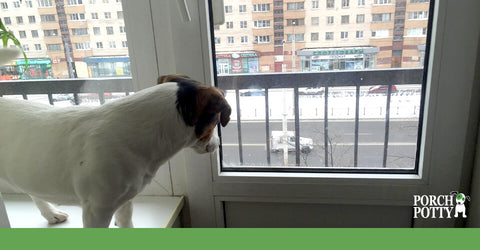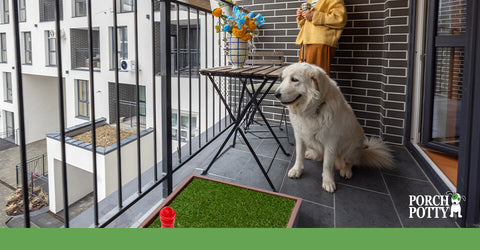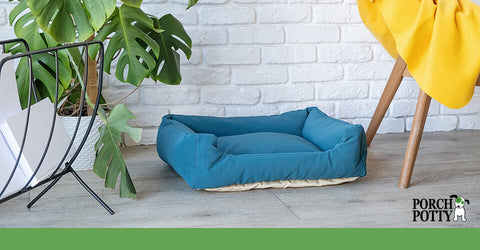
A Jack Russell Terrier stands on a table to look out the window of its flat.
Living in the heart of a bustling city brings its own set of rewards and challenges, especially for dog owners. The urban environment, with its compact living spaces and the absence of wide, open gardens, often leaves pet owners pondering how to provide the best care for their furry friends. Creating a dog-friendly space in your urban home is not just about making a comfortable corner for your pet; it's about integrating their needs into your living environment in a way that's both practical and aesthetically pleasing. This task, though seemingly daunting, is essential for the well-being of your pet and the harmony of your home.
Urban dwellers face unique challenges in this quest, from limited square footage to the need for creative solutions that keep both pets and people happy. However, the importance of this endeavour cannot be overstated. A well-thought-out dog-friendly space not only ensures your dog's happiness and safety but also enhances your living space, making it more welcoming and relaxing for everyone involved. This guide aims to inspire and equip you with practical, actionable advice to transform your urban home into a haven for you and your dog, acknowledging and overcoming the constraints of city living with innovative and thoughtful solutions.
Understanding Your Dog’s Needs
In creating a sanctuary for your dog within the urban jungle, it's essential to start by understanding what your furry companion truly needs from their living environment. While every dog is unique, there are universal requirements that must be met to ensure their happiness and well-being: space, safety, and stimulation.
Space doesn't necessarily mean vast expanses; rather, it's about allocating a specific area in your home where your dog can relax, play, and sleep comfortably. This designated spot should be their safe haven, equipped with a cosy bed, their favourite toys, and enough room to stretch out. In smaller urban dwellings, space-saving solutions like multi-functional furniture can be a godsend, offering your pet their own niche without compromising your living area.
Safety is paramount in an urban setting. Your home should be a secure environment, free from hazards that could harm your pet. This means ensuring windows are secure, balconies are safely enclosed, and potentially dangerous household items are out of reach. Creating a safe space goes beyond physical safety; it's about providing a stable, stress-free environment where your dog can feel secure and loved.
Stimulation is crucial for your dog's mental and physical health, particularly in an urban home where natural exploratory options might be limited. This can be achieved through interactive toys, regular playtime, and puzzles that challenge their minds. Incorporating elements that keep your dog engaged and active not only prevents boredom but also nurtures their physical and cognitive health, making them happier and more balanced pets.
Understanding and catering to these fundamental needs lays the foundation for a truly dog-friendly urban home, ensuring your pet thrives in your shared living space.

A Golden Retriever sits on a balcony of a flat beside a Porch Potty.
Space Optimization Tips
Building on the foundation laid in understanding your dog's needs, let's dive into practical, creative solutions for optimising limited space in your urban home. These tips aim to make your living environment more dog-friendly without sacrificing style or comfort.
Multi-functional Furniture: Embrace furniture that does double duty. A platform bed with built-in storage can house your dog’s toys, bedding, and grooming supplies. Ottomans with hidden compartments offer a cosy nook for your pet to snuggle in while keeping your space tidy and stylish. These versatile pieces allow you to maintain a clutter-free home and provide your dog with their own special place.
Vertical Spaces: Dogs, especially smaller breeds, don't just need horizontal space to roam; they also benefit from vertical exploration. Consider installing wall-mounted steps or a pet-friendly climbing wall that allows them to safely ascend to a dedicated perch or lookout spot. This not only enriches their environment but also takes advantage of underutilised vertical space in small apartments.
Convertible Dog Zones: Create areas that can be easily transformed into a dog-friendly space when needed. A fold-down dog bed attached to a wall can be stored away when not in use, freeing up floor space. A slide-out feeding station in a kitchen cabinet can keep bowls hidden until mealtime. These solutions ensure your pet has everything they need without permanently occupying valuable space.
Use Underutilised Spaces: Look for areas in your home that are seldom used and consider how they might be repurposed for your pet. The space under a staircase, for example, can be transformed into a cosy den with a custom bed and storage for toys and supplies.
Outdoor Solutions: If you have a balcony or small patio, make it a safe and enjoyable space for your dog with weather-resistant beds, outdoor toys, and potted plants that are non-toxic to pets. This extends their living space and gives them a change of scenery. It's also a great place for a dog toilet, like a Porch Potty.
By implementing these space optimization tips, you can create a living environment that meets your dog's needs without compromising on your urban home's aesthetics or functionality.
Creating Safe Zones
In the bustling environment of an urban home, creating safe zones for your dog is crucial for their comfort and well-being. These areas serve as a refuge where your pet can unwind, sleep, or engage in play, away from the hustle and bustle of daily life. Here are some ideas to help you craft these essential spaces:
Designated Sleeping Areas: Choose a quiet corner of your home for your dog's bed, away from high traffic areas and loud noises that might disturb their rest. Ensure this spot is equipped with a comfortable, supportive bed that suits their size and age, along with their favourite blankets for added comfort and security.
Play Corners: Dedicate a specific area for playtime where your dog can enjoy their toys without the risk of tripping anyone. This can be a corner of your living room or a part of your hallway, ideally with easy-to-clean flooring to manage any mess. Store their toys in accessible baskets or bins, encouraging them to use this space for play.
Calm Retreats: For dogs that get anxious or need a break, having a calm retreat is vital. This can be a crate covered with a blanket for a den-like feel or a low-traffic room set up with calming aids like soft music, pheromone diffusers, and comfortable bedding.
By establishing these safe zones, you not only provide your dog with a sense of security and belonging but also integrate their needs seamlessly into your urban living space, ensuring a happy and harmonious home for all.

A blue dog bed sits in a corner by a potted plant and a table.
Dog-Friendly Decor and Materials
Incorporating dog-friendly decor and materials into your urban home not only ensures the safety and comfort of your pet but also maintains the aesthetic appeal of your living space. Here are some suggestions to achieve a stylish yet practical environment for you and your furry friend:
Pet-safe Materials: Opt for durable, non-toxic materials that can withstand the wear and tear of paws and claws. Hardwood floors or tiles are preferable for easy cleaning and resistance to scratches. Rugs made from natural fibres like wool or jute offer a cosy resting spot and are easier to clean than synthetic alternatives.
Easy-to-clean Surfaces: Choose furniture and fabrics that are easy to clean and resistant to stains. Leather or faux leather sofas and chairs are good choices as they can be wiped down quickly, and they resist pet hair adherence. For soft furnishings, look for machine-washable covers and throw blankets that can protect larger pieces from dirt and fur.
Incorporating Pet Items into Home Decor: Make your pet's necessities part of your home's design. Select beds, feeding stations, and toys that complement your interior style. A beautifully designed dog bed can serve as a statement piece, while sleek, modern feeding stations can blend seamlessly with your kitchen or dining area. Storage solutions for pet supplies should be both functional and stylish, with baskets or bins that match your decor theme.
By selecting pet-friendly materials and integrating pet necessities into your home decor thoughtfully, you can create a living space that is comfortable, safe for your pet, and visually pleasing. This approach ensures that your urban home meets your dog's needs while reflecting your personal style.
Maintaining a Clean and Healthy Environment
Maintaining a clean and healthy environment is essential for the well-being of both you and your dog, especially in the confined spaces of urban living. Here are practical tips to ensure your home remains fresh and hygienic:
Regular Grooming: Keeping your dog well-groomed is the first step in controlling pet hair and odours. Regular brushing reduces shedding, while frequent baths (as appropriate for your dog's breed and skin type) can minimise odours. Consider investing in a high-quality pet vacuum cleaner for daily sweeps of areas your dog frequents.
Air Purification: Invest in an air purifier with a HEPA filter to capture pet dander, hair, and other allergens, significantly improving the air quality in your home. Regularly opening windows to allow fresh air to circulate can also help dilute indoor pollutants and reduce odours.
Cleaning Routines: Establish a routine for cleaning your dog's bed, toys, and other accessories. Use pet-safe disinfectants for their belongings and your floors, ensuring the removal of bacteria and viruses without harming your pet. For odour control, natural solutions like baking soda or enzymatic cleaners can be effective in breaking down pet smells without the use of harsh chemicals.
By integrating these hygiene practices into your daily routine, you can create a living space that is not only welcoming and comfortable but also clean and healthy for everyone in your urban home.
As we've explored various ways to create a dog-friendly space in your urban home, remember that this journey is as much about creativity as it is about care. Embracing innovative solutions to enhance your living space for you and your pet can be a rewarding process, reflecting the love and bond you share with your furry companion.
We'd love to see how you've transformed your urban abode into a haven for your dog. Share your stories, photos, and tips with us and become part of a community dedicated to making homes more welcoming for our pets. Let's inspire each other with our creativity and passion for providing the best for our four-legged friends.
For more information on toilet training your dog, check out these articles:
Deciphering Your Dog's Toilet Texture Preference



